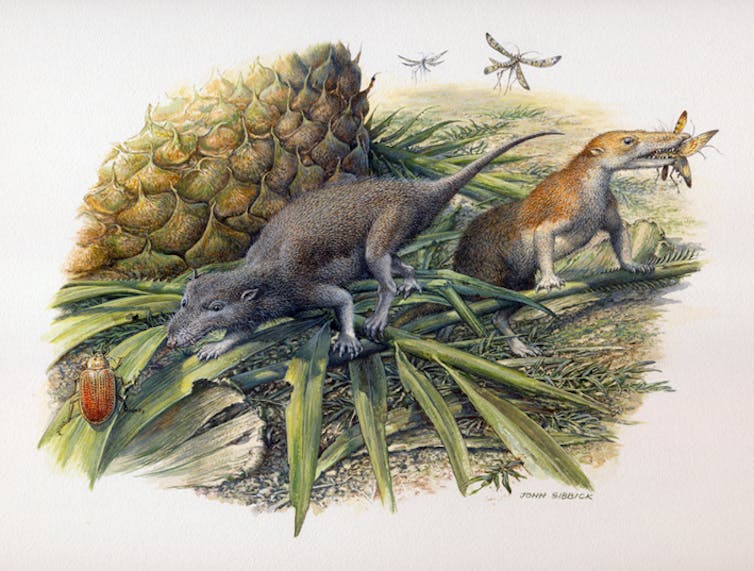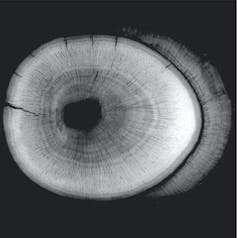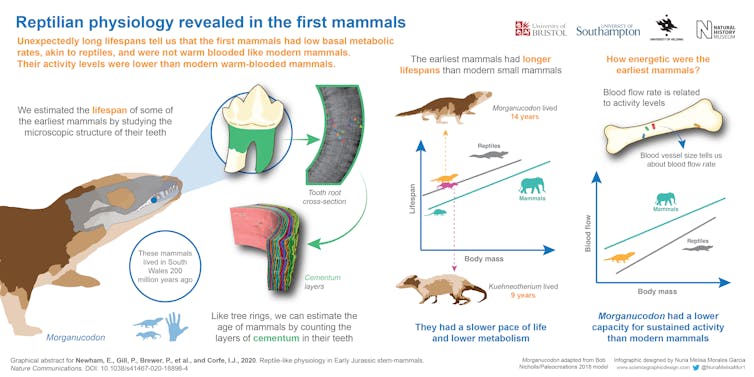Mammals are Warm Blooded - not Quite!
Fossilised teeth reveal first mammals were far from warm blooded

Warm blood is one of the key traits that led to the success of mammals as they evolved from scurrying beneath the feet of dinosaurs to spreading into the wild and wonderful collection of animals we know today. But our new research, which involved X-ray scanning hundreds of fossilised teeth, suggests the first mammals were more like cold blooded reptiles, and that warm blood evolved much later.
Warm blood helps us maintain our body temperature regardless of our environment, allowing us to gather food at night and in cold climates, and helps us stay active for longer than our cold blooded relatives. However, exactly when, why, and how this evolved is still poorly understood.
We know from tiny fossils of bones and teeth that mammals first evolved over 200 million years ago, and had many of the traits we associate with mammals, such as specialised chewing teeth and bigger brains. But the physiologies (how an animal’s body works day-to-day) of these animals is difficult to estimate using traditional methods, as this relates to soft organs that aren’t usually fossilised.
Our new research, published in Nature Communications, now offers a glimpse into the physiologies of the first mammals, by pioneering X-ray imaging to count growth rings in their teeth and measure blood flow through their bones. Although it had previously been assumed that even the earliest mammals were warm blooded, this research suggests that they still had some way to go before developing warm blood and its benefits that we enjoy today.
Long lifespans and slow metabolism
Working with a 20-strong international team of scientists, we have estimated the lifespans of the earliest mammals for the first time. This was done by X-ray scanning hundreds of fossilised teeth found in south Wales of two tiny mammals, Morganucodon and Kuehneotherium, from the Early Jurassic epoch.
High-resolution scans performed at powerful “synchrotron” X-ray sources in Switzerland and France allowed us to count annual growth lines preserved in the fossilised cementum of these teeth. Cementum is the little-known tissue that anchors mammal tooth roots to the jaw, recording every year of an animal’s life by growth lines that can be counted like tree rings to estimate lifespan.

These lines are counted in living mammals by grinding teeth down into thin sections that can be studied using microscopes. As this destroys the tooth, we could not do this with precious museum fossils, and so we used X-ray imaging. Counting rings in our fossil mammal teeth gave a lifespan of 14 years for Morganucodon, and nine years for Kuehneotherium.
These are significantly, and surprisingly, longer lifespans than those of similar, shrew-sized mammals living today whose wild lifespans rarely exceed two to three years. This suggests a dramatically slower metabolism, or pace of life, than living mammals, and instead more closely resembles that of living reptiles.
Low activity levels
The size of the openings for the major blood vessels running through an animal’s limb bones is known to be proportionate to the levels of sustained activity (such as hunting and foraging) that they are capable of: smaller size suggests lower activity levels.
When we measured this in the femur of Morganucodon, we found that, while smaller than living mammals, they were also higher than those of living reptiles. This suggests that early mammals had an intermediate ability for sustained activity, between warm blooded mammals and cold blooded reptiles.

This combined approach of studying the lifespans and activity levels of early mammals provides the first direct window onto several aspects of how they lived. We can see that our earliest relatives kept a much slower pace of life, but had definitely started on the road to the active lifestyles of living mammals today.
We shall continue these studies through the early mammal fossil record, to shed light on the first steps towards the modern mammalian lifestyle, and when we truly became warm blooded.![]()
Elis Newham, Research Associate in Palaeontology, University of Bristol and Pam Gill, Senior Research Associate in Palaeontology, University of Bristol
This article is republished from The Conversation under a Creative Commons license. Read the original article.
No comments:
Post a Comment